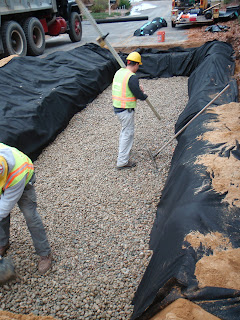by Abigail Franklin
There’s a new fish ladder in North Falmouth
and it’s just waiting for some river herring to try it out! For the past several years migrating river
herring have had to swim up a fish ladder that was on the verge of collapse. Not this year!
 |
| The old dilapitated fish ladder. |
The river herring have already begun their
journey from the deep ocean into Buzzards Bay.
When the water temperature gets closer to 50 degrees they’ll swim into
Megansett Harbor and then a saltmarsh called Rands Canal where they will encounter
a brand new concrete pool and weir fish ladder. Their ultimate destination is a
freshwater pond called Cedar Lake where they will spawn – but first they must
overcome a five foot height difference between the Canal and the stream and then
swim under a road.
The fish have been making this journey for
hundreds of years and the citizens of Falmouth have helped them swim past man
made obstacles by building fish ladders.
The circa 1930s fish ladder at this site worked well for more than 70
years but time and tide caused it to eventually crumble. Town of Falmouth staff have had to make
repairs to the fish ladder every year, as well as the small culvert under the road
that often was clogged with sticks and leaves.
It was only a matter of time before the stream would have become
impassible.
 |
| The new fish ladder under construction. |
With funding from the Cape Cod Water
Resources Restoration Project the Town of Falmouth was able to design and build
a new ladder and a larger culvert that will be easier to maintain.
Construction of the ladder,
culvert, and roadway began in May 2013 and was completed in November 2013. The
project was especially challenging because one lane of the road had to remain
open at all times so the neighbors could get to their homes, and because a dry
work environment had to be created in an area where the tide moves in and out.
 |
| The new fish ladder was completed last November. |
The new ladder is 66 feet
long and has nine pools that break up the height difference into manageable steps
for the herring to swim through. The
Town also made improvements to the roadway that will reduce the runoff of
pollutants and sand into the stream, and constructed a platform and walkway
that will allow staff to access the ladder without eroding the banks.

















